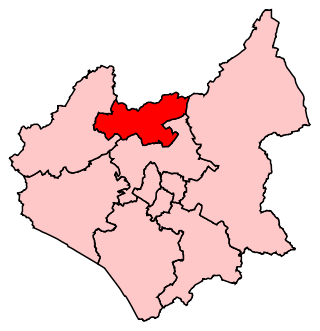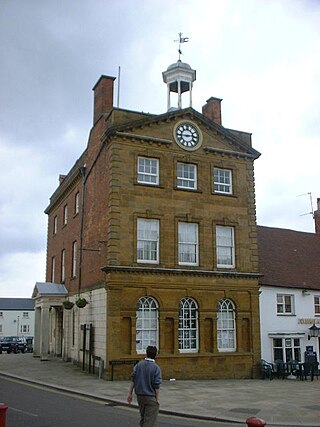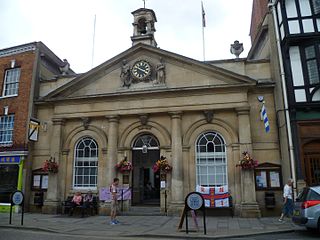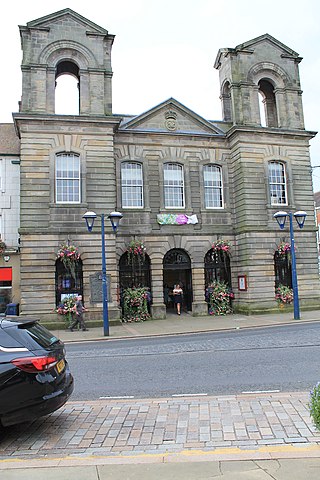
Leicestershire is a ceremonial county in the East Midlands of England. It is bordered by Derbyshire, Nottinghamshire, and Lincolnshire to the north, Rutland to the east, Northamptonshire to the south-east, Warwickshire to the south-west, and Staffordshire to the west. The city of Leicester is the largest settlement and the county town.

Loughborough is a market town in the Charnwood Borough of Leicestershire, England, the seat of Charnwood Borough Council, and the location of Loughborough University. At the 2021 census the town's built-up area had a population of 64,884, the second largest in the county after Leicester. Loughborough is close to the Nottinghamshire border and short distances from Leicester, Nottingham, East Midlands Airport, and Derby. It has the world's largest bell foundry, John Taylor Bellfounders, which produced Great Paul at St Paul's Cathedral, as well as making bells for the Carillon War Memorial, a landmark in the Queens Park in the town, and for York Minster.

Charnwood is a local government district with borough status in the north of Leicestershire, England. It is named after Charnwood Forest, much of which lies within the borough. The council is based in Loughborough, the area's largest town. The borough also contains the towns of Shepshed and Syston, along with numerous villages and surrounding rural areas. In the south of the borough it includes parts of the Leicester Urban Area, notably at Birstall and Thurmaston.

Shepshed is a market town and civil parish in the Charnwood Borough of Leicestershire, England with a population of 14,875 at the 2021 census. It is the second biggest settlement in the borough, after the town of Loughborough.

Burton on the Wolds is a village in Leicestershire, England situated on the B676 road 3 miles (4.8 km) west of the A46 and about the same distance to the east of Loughborough, close to the county border with Nottinghamshire. In the 2011 census, the population was measured at 1,218. The Parish Council of Burton on the Wolds, Cotes and Prestwold serves the village and its two neighbouring hamlets. The local borough council is Charnwood.

Loughborough is a constituency in Leicestershire represented in the House of Commons of the UK Parliament since 2019 by Jane Hunt, a Conservative. From 2010 until 2019, it was represented by Nicky Morgan, who served in the governments of David Cameron and Boris Johnson. In 2020, she was elevated to the Peerage and became a member of the House of Lords. The constituency is a considered a bellwether, as it has reflected the national result at every general election since February 1974.

The Old Town Hall, Richmond on Whittaker Avenue in Richmond, London is a former municipal building which from 1893 to 1965 served as the town hall for the Municipal Borough of Richmond.

Thornaby Town Hall is a municipal building in the Mandale Road in Thornaby-on-Tees, North Yorkshire, England. The building, which is owned by Thornaby Town Council, is a Grade II listed building.

Kidderminster Town Hall is the town hall of Kidderminster, Worcestershire, England. The complex, which includes the corn exchange and the town hall and is the home of Kidderminster Town Council, is grade II listed.

Brighouse Town Hall is a former municipal building in Thornton Square, Brighouse, West Yorkshire, England. The town hall, which was the headquarters of Brighouse Borough Council, is a Grade II listed building.

The Moot Hall is a municipal building in Chapel Lane in Daventry, Northamptonshire, England. The building, which was the headquarters of Daventry Borough Council, is a Grade II* listed building.

Tewkesbury Town Hall is a municipal building in the High Street in Tewkesbury, Gloucestershire, England. The building, which is the meeting place of Tewkesbury Town Council, is a Grade II* listed building.

Devizes Town Hall is a municipal building in St John's Street in Devizes, Wiltshire, England. The structure, which is the meeting place of Devizes Town Council, is a Grade II* listed building.

Morpeth Town Hall is a municipal building in the Market Place, Morpeth, Northumberland, England. The structure, which was the meeting place of Morpeth Borough Council, is a Grade II listed building.

Blandford Forum Town Hall is a municipal building in the Market Place in Blandford Forum, Dorset, England. The 18th-century structure, which was the meeting place of Blandford Forum Borough Council, is a Grade I listed building.

Helston Guildhall, also known as Helston Town Hall, is a municipal building in Church Street, Helston, Cornwall, England. The structure, which is the meeting place of Helston Town Council, is a Grade II* listed building.

Langport Town Hall is a municipal building in Bow Street in Langport, Somerset, England. The building, which is the meeting place of Langport Town Council, is a Grade II listed building.

The Town House is a municipal building in Union Street in Yeovil, Somerset, England. The building, which is the meeting place of Yeovil Town Council, is a Grade II listed building.

The Corn Exchange is a commercial building in Market Street, Witney, Oxfordshire, England. The structure, which is used as a public events venue, is a Grade II listed building.

Sunderland Town hall was a municipal building in the Fawcett Street in Sunderland, Tyne and Wear, England. It was the headquarters of Sunderland Borough Council until November 1970.





















